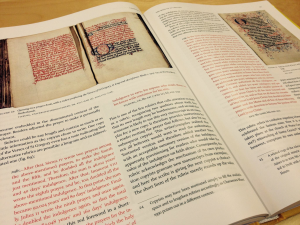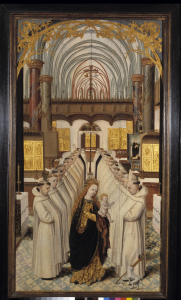How images fuelled the mania for indulgences in pre-Reformation Europe
2017 marks the 500th anniversary of an apocalyptic event in European history: Martin Luther nailed up the 95 Theses criticising abuses of the Roman church, including selling indulgences. With this action Luther set into motion the Protestant Reformation, arguably one of Europe’s biggest social upheavals. In her ground-breaking new book, Kathryn M. Rudy, Senior Lecturer in Art History at the University of St Andrews, investigates the crucial role images played in t he mania for indulgences that characterised the decades before the Reformation.
he mania for indulgences that characterised the decades before the Reformation.
Published in December 2016 by Brill, Rudy’s book is the first to analyse systematically the interplay of images and indulgences in pre-Reformation Europe. Drawing upon hundreds of manuscript prayerbooks and numerous unpublished sources, she demonstrates how indulgences and images worked symbiotically to market certain images and popularise particular indulgences. Her work focuses on manuscript prayerbooks written in Middle Dutch for literate people living in the Low Countries during the fifteenth century. The Netherlanders had an exceptionally advanced book-making culture and high literacy rates. Their books recorded and prescribed cultural norms of behaviour in an era when people often owned just one book – a prayerbook – and the impious were ostracised. Prayerbooks thus exercised a powerful hold on both private and public behaviour.
The manuscript prayerbooks studied in Rudy’s new work were made at a time when the faithful understood they had to pay for their sins by spending time in Purgatory, where their souls would be cleansed. Believers could reduce their sentence by reciting certain prayers. Preachers communicated this fire-and-brimstone thinking, whipping up a fervour for indulgences. Rudy’s study shows that people performed particular prayers in front of images, such as the Virgin of the Sun, the Mass of St Gregory, the Trinity or a crucifix in order to earn these coveted indulgences. She asks: how did believers behave in front of images? What purgatorial remissions and rewards did they expect as a result of their performed prayers? What role did the text play in conditioning both the use of images and their production?
Rudy’s pioneering study was funded with a three-year research grant by the Nederlandse Organisatie voor Wetenschappelijk Onderzoek (NWO), the national research council for The Netherlands. During her research she studied more than 500 manuscripts and mastered the Middle Dutch language, enabling her to transcribe the instructions for prayer embedded in late medieval prayerbooks. Called rubrics and often written in red, these instructions effectively tell the reader how to pray. Rudy finds examples instructing the believer to ‘read the following prayer in the presence of an image of the Virgin of the Sun’, and the results they could expect. Rewards could be great. For reading a particular prayer in front of an image the Virgin of the Sun, the faithful could reduce their time in Purgatory by 11,000 years.
Further information and comments:

Andrew Pettegree, Professor of History at the University of St Andrews, comments: “A really beautiful, insightful and original book. Any Reformation historian who wants to understand the importance of indulgences will want to read it.”
Brill calls it “without doubt one of the most beautiful books we’ve published this year.”
Please ask your institution’s librarian to order a copy, available from Brill at: http://www.brill.com/products/book/rubrics-images-and-indulgences-late-medieval-netherlandish-manuscripts
For a review copy, ask a journal editor to request one at: http://www.brill.com/about/policies/review-brill-book. Thank you.
Notes to editors:
For further information on Rubrics, Images, and Indulgences or quotes from the author, please contact Kathryn M. Rudy by email: [email protected]
For all press enquiries including hi-res images please contact Julia Faiers at Social Media Clinic
email [email protected] tel: +33 683 171117